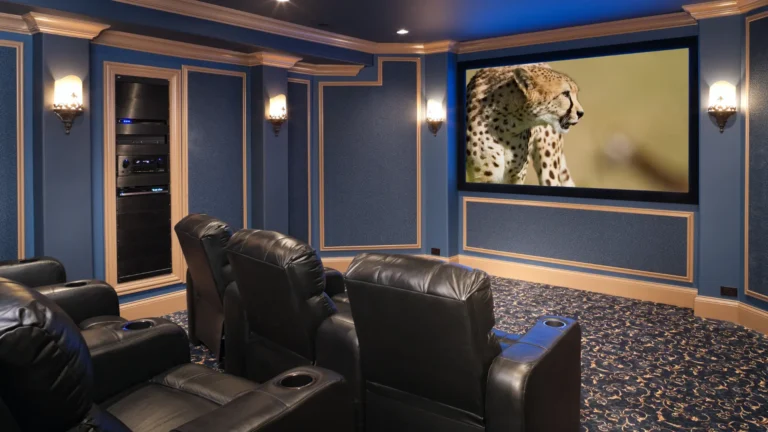Setting up a home theater is a great way to upgrade your entertainment space, whether it’s your living room, basement or dedicated media room. With the set up a home theater, you can enjoy movies, sports and games with immersive sound and visuals that rival commercial theaters. Here’s a simple step by step guide to help you create the best home theater system without getting bogged down in technical jargon.
Choose the Right Room for Your Home Theater
First, choose the best room in your home for the theater setup. Ideally, it should be a room where you can control the lighting and minimize outside noise. Basements, spare rooms, or even a section of your living room can work well. Consider:
- Room size: Big enough to fit your seating and equipment, but not so big that sound gets lost.
- Lighting: Rooms with minimal natural light are best to avoid glare on your screen.
- Acoustics: Rooms with soft furnishings, carpet, and curtains help absorb sound and reduce echoes.
Plan Your Home Theater Layout
Before you buy equipment, sketch out a floor plan of your room. Measure dimensions and decide where to put your screen, speakers, and seating. Good planning ensures optimal viewing angles and sound distribution.
- Screen placement: Place your home theater screen or 4K Ultra HD TV at eye level when seated.
- Seating: Arrange seats so everyone has a clear view without straining their neck.
- Speaker placement: Plan spots for your surround sound system speakers around the room.
Choose Your Display: TV or Projector?
Your display is the heart of the home theater experience.
- 4K Ultra HD TV: Bright, sharp images and easy to set up. Good for rooms with some ambient light.
- Home theater projector: Bigger image and true cinema feel especially when paired with a home theater screen. Best for darker rooms.
If you choose a projector, invest in a good home theater screen to get the best picture clarity.
Setting Up Your Surround Sound System
Sound is just as important as the picture. A good surround sound system makes you feel like you’re in the action.
Components You’ll Need:
- AV receiver: This is the hub that powers your speakers and manages audio and video signals.
- Speakers: Typically, a 5.1 system includes a center channel, two front speakers, two rear surround speakers, and a subwoofer.
- Subwoofer: Handles deep bass sounds, adds impact to explosions or music.
- Speaker cables: To connect everything.
Speaker Placement Tips:
- Place the center channel speaker above or below the screen; it handles most dialogue.
- Front left and right speakers on either side of the screen, angled towards the main seating area.
- Rear surround speakers behind or to the sides of the seating area; angled inwards.
- Speakers 1-2 feet above ear level for best sound projection.
- Subwoofer placement varies; try corners or along walls to find where bass sounds best without overwhelming the room.
Calibrate Your Sound:
Many AV receivers come with a microphone for auto calibration. Place mic where you sit and the receiver will adjust volume levels and delays for each speaker to your room’s acoustics. If not, adjust speaker levels until sound feels balanced and immersive.
Connect Your Audio and Video Devices
Once speakers and screen are in place, connect all devices:
- Use high-quality HDMI cables for video and audio.
- Connect the Blu-ray player and streaming media player to the AV receiver or directly to the TV/projector.
- Set the AV receiver to recognize each device and select the correct input source.
Consider a Soundbar Setup for Easy
If wiring a full surround sound system seems daunting, a soundbar setup is a great alternative. Modern soundbars can simulate surround sound and often include a wireless subwoofer for deep bass. They’re easier to install and take up less space, perfect for smaller rooms or renters.
Arrange Your Seating
Your seating should match your home theater:
- Choose comfortable chairs or sofas with good back support.
- Seats at an ideal distance from the screen; typically 1.5-2.5 times the diagonal screen size.
- Recliners or sectional sofas for a cozy theater feel.
Final Tips to Set Up a Home Theater Better
- Control ambient light with blackout curtains or dimmable lights.
- Use rugs and wall hangings to improve room acoustics.
- Keep remotes and cables organized.
- Update streaming media player and AV receiver firmware regularly.
Start Building Your Home Theater Today
You don’t have to be a tech expert or break the bank to build your dream home theater. Choose the right room, get quality equipment like a 4K Ultra HD TV or home theater projector, set up a surround sound system with proper speaker calibration and subwoofer placement, and make it comfortable, and you’ll be enjoying your home entertainment like never before. Whether you go full AV receiver and speaker setup or soundbar system, the key is to have great sound and picture. So get your gear, plan your layout, and start building your home theater today!
